Emailing your professor can be nerve-racking if you’re unsure of how to even start.
With many classes moving online, online email communication is more important than ever. It’s necessary to learn the proper email etiquette for professors so that you can thrive in class and maintain a good rapport with your professor.
To learn how to email a professor, keep reading.
We’ll break down an email step by step so that any concerns about how to write an email to a professor will be answered!

Want Support As You Navigate the College Scene?
Sign up to Goodwall!
- Connect with like-minded students from 150+ countries
- Search through over $1.5 million in scholarships
- Ask your university questions and get support
Download the app now to get started for FREE!
How To Write An Email to a Professor: The Basics
Before getting started, there are some general unspoken guidelines to follow before you understand how to write an email to a professor. Firstly, try to answer your question before sending an email. Many professors are busy with classes, conducting research, attending conferences, and so on.
If your concerns cannot be met through information in the syllabus, assignment instructions, or elsewhere, then you can go ahead with your email.
A lot of the time, there is a community page in your classes’ online forum. This is a great additional resource to look into for the information you need.
When going to write your email, remember to keep it friendly but professional. Writing an email to a professor is similar to writing an email to a boss. You want the language to be professional, not divulging too much personal information.
Certainly, shy away from using slang and language you would use to speak to friends. Be polite, considerate, and respectful while writing a professional email.
Short, concise messages are the ideal way to communicate with your professor. Try to provide all of the information they need so that they do not have to waste a ton of time playing email tag with you.
Lastly, always use your school email address to communicate with your professor. State which class and session you’re from so they don’t have to spend time tracking down who you are. Providing this information is appreciated by professors.
Related Read: 15+ Best Study Tips: Top Advice & Effective Ways to Study Better
Subject Line
Your subject line should clearly communicate the main message of your email. How to email your professor begins with the subject line and purpose for emailing in the first place. Sometimes writing out the subject line after you write the email helps to clarify exactly what you need.
It’s a good idea to put the course title and number followed by a brief explanation of what you’re communicating about. Not only does including the course title in the subject line help eliminate the email from going to spam, but it gives the professor valuable information before even starting to read the email.
Getting Started: Salutations
Now it’s time to write the email. You’ve set yourself to be successful so far. All you have to do is get the structure formatted, and you’re good to go.
For the greeting, keep it short and polite. Start by typing ‘Dear _____’.
Check the syllabus to see how your professor refers to themselves. Sometimes professors will want to be called ‘Dr.’ and other times ‘Professor’ followed by their last name is just fine. Saying dear or hello in the greeting keeps the exchange professional.
Opening Paragraph
An email sent to a professor is outlined, kind of like an essay. You’ll have your opening paragraph, body paragraph, and conclusion.
For the introduction, introduce yourself. That way, your professor knows who is sending the email. If you’ve had any previous exchanges with your instructor thus far, you can mention them here. This helps jog their memory to place a face to your name.
The introduction is where you should include your course number and title. While your instructor probably teaches more than one of the same classes, you’ll need to get specific by mentioning the dates and times you meet.
You can take a moment to exchange niceties, but don’t go too into depth about subject matter that isn’t important to your email. Wishing them a nice week, referring to a movie they brought up in class, and so forth, is a good way to stay pleasant.
After this, get right to it.
Related Read: 25 Best Apps for College Students: Productivity, Studying, Learning & More
Body Paragraph
This is the bulk of the email that explains your problem and what you need from your professor to solve it. In this section, it’s good to be as detailed as possible. This avoids any confusion. You want your email to be resolved in as short of a time as possible, so details help.
This is where the purpose of your email comes in. If you have a question, comment, or concern, state it here. While you should provide all of the information your professor needs, don’t divulge unnecessary details.
Providing all of the information they need without wasting their time shows you respect them and what they do as a profession. Students who are unaware of how time-consuming being a professor is, tend to disrespect their professors. Going out of your way to make your question easily answered is appreciated.
Your professor is not interested in excuses. If the reason you’re emailing is due to being late on an assignment, they aren’t really interested in hearing your elaborate excuse story.
There are exceptions to this, of course. Emergencies do happen, and a lot of professors grant leniency if you create an open line of communication with them. It’s best to give them a heads up if you turn an assignment in late due to an emergency as soon as you’re able.
Professors understand that things out of your control occur and will be willing to work with you. Do not make a habit of turning in late assignments.
Wrap Things Up
After explaining your situation, clearly state what you need. A call to action makes this communication effective. Simply stating, ‘I need XYZ from you,’ tells them exactly what they need to do.
Don’t be afraid to be direct about what you need. If you’re asking for a letter of recommendation, simply say this. If you need a form signed, state this as well. No matter your situation, don’t tip-toe around what you need from your professor.
To close the bulk of the email, there are many statements you can try. These include:
- Thanks for your time
- I look forward to hearing from you
- I look forward to your class
- Thanks for taking the time to talk
These are only some examples of what you can say to show your gratitude. Thanking them expresses gratitude, and it’s the perfect way to end the email.
Related Read: 25+ Best History Books of All Time for a Solid Understanding of Our World
Finishing Touches
Figuring out how to end an email to a professor is easy. The finishing touches will be your closing signature. Most emails can be closed with ‘Sincerely,’ ‘Best,’ or ‘Thanks again,’ followed by your name.
After concluding your email, it’s time to double-check it. Reread your email to make sure there are no grammatical or spelling errors. You don’t want to send an email with errors and make your professor get the wrong idea.
Taking the extra minute to go over your email is the last step to making sure the tone is professional and concise. Make sure your course number is displayed correctly, and the subject line matches your intentions.
Following Up
You may need to follow up with your professor. They tend to get busy and could easily overlook your email or forget about it. Many professors do not reply to emails that do not need a reply.
If professors replied to every email they got sent, their whole job would just be responding to emails. Keep in mind that your professor is busy. Give them time to get back to you.
Look over your syllabus to see if your professor states what their email policy is. They might tell you exactly how long you can expect a reply. If not, waiting 48 hours for a response before following up is a good general rule.
Here is how to start an email to a professor if you’re following up. Keep this one very short. Forward your previous email to them and include a subject line that says ‘Following up on the Previous Email.’
Give them a short response that says you’re just following up in case your professor missed or overlooked the email. This is pretty much all you need to do in this scenario, and now you wait.
Related Read: Glossary of College Terms: 25+ Important University Words to Understand
You’re Ready to Hit Send
Now you know how to email a professor. These guidelines are enough to get you started with any question or concern you have. Be confident in your written communication abilities.
Remember the basic rules of staying polite and professional. Beyond this, your specific needs will have to be communicated by you.
If you’re looking for a community of other young professionals with good resources to get your bio in the marketplace while using resources to be successful in school and a career, have a look at the rest of our blog. Thanks for reading!



